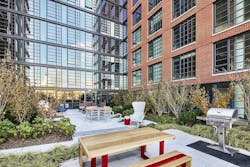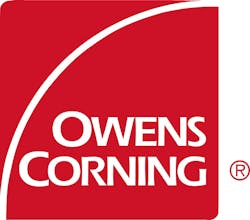From the Top: 3 Trends Influencing the Future of Commercial Roofs
Today’s commercial roofs are opening up new frontiers for the building enclosure, providing access to nature, delivering compressive strength, and elevating environmental sustainability efforts. Below, we consider how these trends are playing out in commercial buildings and influencing the design of high-performing vegetative roof assemblies (VRAs):
Trend #1: Biophilia. Referring to an innate human instinct to connect with nature and living beings, biophilia literally translates to “love of life.”Biophilic design connects the built environment to the natural world around it. According to the Natural Resource Design Council, NRDC, biophilic benefits are associated with cognitive function, physical health and psychological well-being.
From an employee perspective, a 2018 study by L.L. Bean found that 86% of indoor workers reported they would like to spend more time outdoors during the workday. Sixty-five percent of respondents in the study cited their job as the biggest factor keeping them indoors. Given employer competition for talent, a work environment offering access to nature can provide an attractive benefit to prospective employees.
VRAs open up vistas for enjoying nature, even in highly urbanized settings. For example, the District Wharfin Washington D.C. is a public-private partnership spanning nearly a mile of Potomac riverfront. The roofs provide outdoor space for taking in historic landmarks or simply taking in fresh air. Several of the roofs at the Wharf rely on Owens Corning® FOAMULAR® 404 and 604 extruded polystyrene insulation (XPS). The material delivers compressive strength while supporting the District’s robust codes governing stormwater runoff. The properties that differentiate XPS from other insulation products, such as exceptional moisture resistance and durability, make it an ideal insulation for VRAs. The National Roofing Contractors Association (NRCA) recommends XPS be used as the thermal insulating material for VRA applications. As the material’s water resistance helps protect its R-value and thermal performance, its compressive strength can withstand the weight of vegetation.
Dickies Arena in Fort Worth, Texas brings an element of biophilia to a world-famous rodeo. Home to the Fort Worth Livestock Show, the rodeo venue hosts a Texas-size plaza deck that allows attendees to enjoy open-air events and take in the city’s iconic skyline. A rooftop cork-yard provides a relaxing respite for enjoying a glass of wine, while a window built into the plaza deck permits attendees to look down on livestock before rodeo performances. Again, a VRA sandwich including Owens Corning® FOAMULAR® XPS supports the plaza deck’s performance. The plaza deck must be strong enough to support vehicular traffic, including emergency vehicles and the trucks that deliver equipment for plaza deck concerts.
Trend #2: Extreme Weather. Episodes of extreme weather are occurring with alarming frequency. The National Oceanic and Atmospheric Association reported that 2020 was a record-breaking year for weather – with 22 billion-dollar weather events. 2020 was the sixth consecutive year in which 10 or more billion-dollar weather and climate disaster events occurred in the U.S. The use of XPS insulation in VRAs can help manage stormwater and comply with more rigorous building codes. Roofs at the District Wharf using Owens Corning® FOAMULAR® 404 and 604 XPS insulation include various vegetation that act like giant sponges to absorb water. The protected roof membrane assembly (PRMA) plays a critical role in storing water in the vegetated areas or directing water to cisterns where it is collected. The PRMA consists of insulation under the plant layer as well as growing media and a filter/drainage layer atop the roof’s waterproofing layer.
As anyone who has visited Fort Worth in the summer can attest, temperatures can soar into the triple digit range. Urban areas with a high concentration of buildings, highways and infrastructure often have limited greenery, allowing heat to be absorbed and reemitted. The result is a “heat island” with higher temperatures compared to outlying areas. A review of research found that the heat island effect results in higher daytime temperatures of 1 to 7◦F in urban areas and higher nighttime temperatures of about 2 to 5°F compared to outlying regions.1 Vegetation is a novel and “cool” approach to mitigating the urban heat island effect in applications such as the Dickies Arena plaza deck. Trees, vegetation and water bodies tend to cool the air by providing shade, transpiring water from plant leaves, and evaporating surface water.
Trend #3: Environmental Sustainability. According to the U.S. Energy Information Administration, buildings account for about 40% of all U.S. energy consumption and a similar proportion of greenhouse gas emissions.2 New regulations are inspiring manufacturers to research and develop building materials with dramatically lower global warming potential (GWP)– including materials to support commercial roofs. In 2021, Owens Corning was awarded the 2021 Manufacturing Leadership Award for its outstanding achievement in material science innovation supporting environmental sustainability. Additionally, Owens Corning was named a “High Achiever” for receiving the highest score among awardees in the “Sustainability Leadership” category.
The innovation — FOAMULAR® NGX™ (Next Generation Extruded) extruded polystyrene (XPS) insulation — reflects Owens Corning’s goal to reduce global greenhouse gas emissions 50% by 2030. FOAMULAR® NGX™ features a proprietary blowing agent that delivers a 90% reduction in GWP compared to legacy FOAMULAR® insulation blowing agents.*Researchers evaluated more than 100 blowing agent formulations and developed proprietary manufacturing processes to achieve a greater than 80% reduction in total product embodied carbon.Validated by a third-party verified Environmental Product Declaration and Optimization Report, the new XPS delivers a greater than 80% reduction in GWP and qualifies as 1.5 products towards LEED 4.1 points for Options 1 and 2 under the Materials and Resources: Environmental Product Declaration (EPD).
VRAs provide a high-performing solution that spans geographies and unique topographies. For example, one of the nation’s largest VRAs – the Douglas A. Munro Coast Guard Headquarters in Washington, D.C. brings a terraced landscape to rooftop design. Nine of the 11 levels were built into the hillside. The stair-stepped green roof terraces make use of Owens Corning® FOAMULAR® 404 and 604 extruded polystyrene (XPS) insulations as the design gradually moves water from higher to lower levels and eventually into a pond.
VRAs provide an attractive approach to addressing emerging trends including biophilia, extreme weather and more stringent environmental regulations.
- U.S. Environmental Protection Agency. (July 30, 2020). Learn About Heat Islands. Retrieved from https://www.epa.gov/heatislands/learn-about-heat-islands.
- 2 U.S. Energy Information Administration. (May 3, 2021). How much energy is consumed in U.S. Buildings? Retrieved from https://www.eia.gov/tools/faqs/faq.php?id=86&t=1.
*Impact measured over 100-year time horizon, as compared to FOAMULAR® blowing agent formulation.
Contact Info:
Phone: 1-800-GET-PINK
Email: [email protected]
Website: www.owenscorning.com/foamular-ngx


